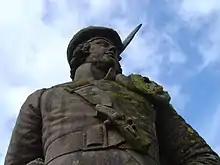Glenfinnan
Glenfinnan (Scottish Gaelic: Gleann Fhionnain[3] [klan̪ˠˈʝũn̪ˠɛɲ]) is a hamlet in Lochaber area of the Highlands of Scotland. In 1745 the Jacobite rising began here when Prince Charles Edward Stuart ("Bonnie Prince Charlie") raised his standard on the shores of Loch Shiel. Seventy years later, the 18 m (60 ft) Glenfinnan Monument, at the head of the loch, was erected to commemorate the historic event.
Glenfinnan
| |
|---|---|
 The monument at Glenfinnan | |
 Glenfinnan Location within the Lochaber area | |
| Population | 120 [2] |
| OS grid reference | NM897803 |
| Council area | |
| Lieutenancy area | |
| Country | Scotland |
| Sovereign state | United Kingdom |
| Post town | GLENFINNAN |
| Postcode district | PH37 |
| Dialling code | 01397 |
| Police | Scotland |
| Fire | Scottish |
| Ambulance | Scottish |
Jacobite rising
.svg.png.webp)
Prince Charles landed from France on Eriskay in the Western Isles, travelling to the mainland in a small rowing boat, coming ashore at Loch nan Uamh just west of Glenfinnan. On arrival on the Scottish mainland, he was met by a small number of MacDonalds. Stuart waited at Glenfinnan as more MacDonalds, Camerons, Macfies, and MacDonnells arrived.
On 19 August 1745, after Prince Charles judged he had enough military support, he climbed the hill near Glenfinnan as MacMaster of Glenaladale raised his royal standard. The Young Pretender announced to all the mustered clans he claimed the British throne in the name of his father James Stuart ('the Old Pretender'). A MacPhee (Macfie) was one of two pipers with Bonnie Prince Charlie as he raised his banner above Glenfinnan. After claiming the throne, brandy was distributed to the assembled highlanders to celebrate the occasion.
Eight months later, the Jacobite claim to the throne ended in failure at the Battle of Culloden on 16 April 1746. Many Macfies from Glenfinnan followed Donald Cameron of Lochiel on the right flank of the Jacobite Army at the battle.
Charles Stuart returned to the area after Culloden during his flight to evade the Government troopers of Prince William, Duke of Cumberland. After taking refuge with loyal supporters, he boarded a French frigate on the shores of Loch nan Uamh close to where he landed and raised his standard the previous year. The Young Pretender died in Rome in 1788 without setting foot on Scottish soil again. The Prince's Cairn marks the spot from where he departed into exile.
Monument

By 1815, the Jacobite cause was no longer a political threat to the Hanoverian monarchy. Alexander Macdonald of Glenaladale, a minor branch of the Clan Donald, built a memorial tower at Glenfinnan to commemorate the raising of the standard of the Young Pretender. The tower, which is 18 metres in height, was designed by the Scottish architect James Gillespie Graham.[4] The statue of an anonymous highlander, referred to at the point of commission as Charles Edward Stewart, by John Greenshields, was added in 1835.[5]
The monument's location at Glenfinnan was made possible because of an 1812 new road, now the A830 road, built by Thomas Telford, opened between Fort William to Arisaig.
Since 1938, the Glenfinnan Monument has been in the care of the National Trust for Scotland. The Trust constructed a visitor centre, providing tickets, information, exhibitions, a shop, café, and toilets. The tower is also a monument to Alexander Macdonald, but he perished before its completion. Jacobite enthusiasts gather at the tower each year on 19 August to remember the Rising of '45.
Railway

Station
Glenfinnan is about halfway between Fort William and Mallaig on the picturesque West Highland Railway. Along with a regular rail service by Abellio ScotRail, the line is used by the Jacobite steam train. A private railway museum operates at the station, using the former booking-office, the disused signalbox, and some stored coaches.
Viaduct
Sir Robert McAlpine had the Glenfinnan Viaduct constructed between 1897 and 1898. The structure, which is built entirely out of concrete, has 21 arches with spans of 15 m (49 ft) and reaches a height of 30 m (100 ft) above the valley. To commemorate the viaduct's centenary in 1997, a plaque was unveiled at the base of one of its arches.
The landscape in which the viaduct is located has made it popular with film producers. In 1969, it was used in Ring of Bright Water, starring Bill Travers and Virginia McKenna. It has since come to prominence in the cinematic releases of the Harry Potter series. The Hogwarts Express, is filmed crossing the viaduct in several of the films beginning with Harry Potter and the Chamber of Secrets in 2002. The train filmed is the Jacobite Steam-Locomotive Train, a tourist train.
In popular culture
In the Highlander universe, Connor and Duncan MacLeod are both Scots born in Glenfinnan in 1518 and 1592, respectively. Eilean Donan castle is used as a stand-in for Glenfinnan in the franchise.
References
- "Ainmean-Àite na h-Alba – Gaelic Place-Names of Scotland – Database". www.gaelicplacenames.org. Retrieved 23 April 2017.
- Census, 2011
- "Ainmean-Àite na h-Alba – Gaelic Place-Names of Scotland – Database". www.gaelicplacenames.org. Retrieved 23 April 2017.
- Boundless magazine article, Sept/Oct 2020, page 25
- http://www.glasgowsculpture.com/pg_biography.php?sub=greenshields_j
External links
| Wikimedia Commons has media related to Glenfinnan. |
| Wikivoyage has a travel guide for Glenfinnan. |

